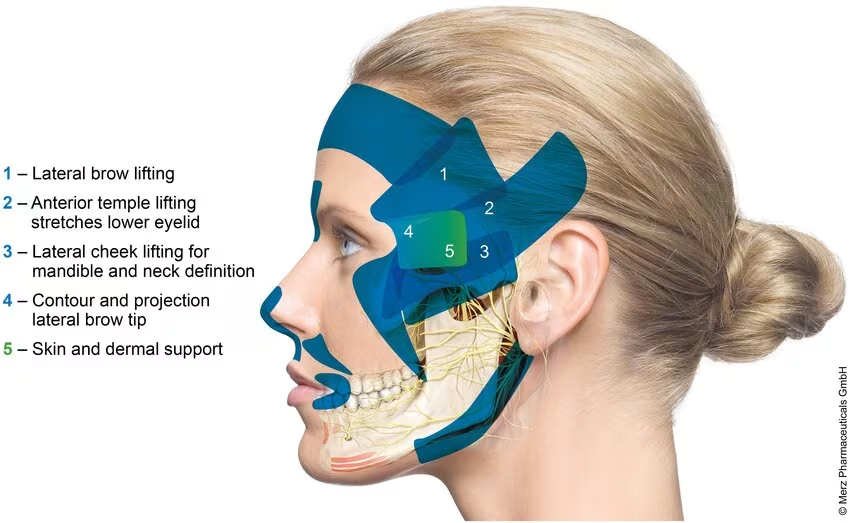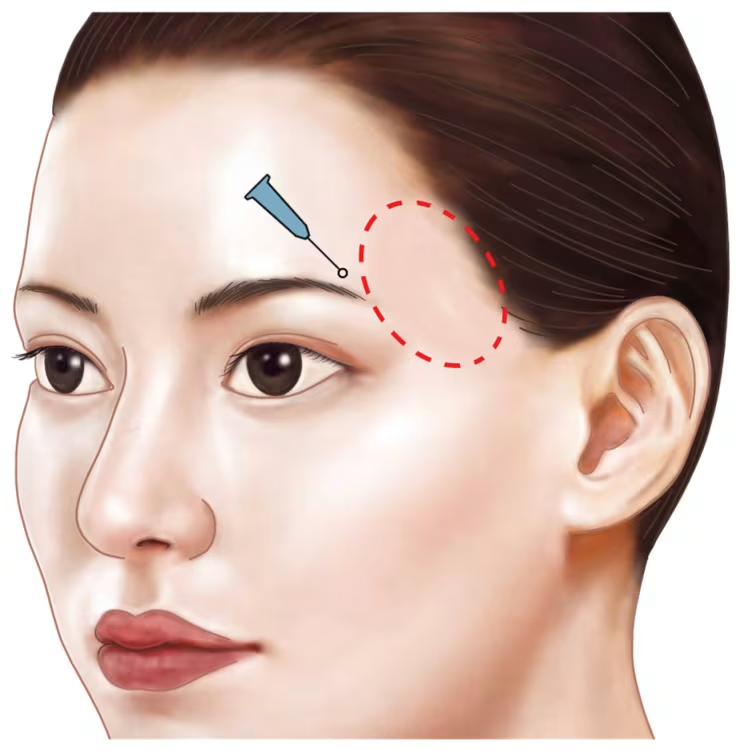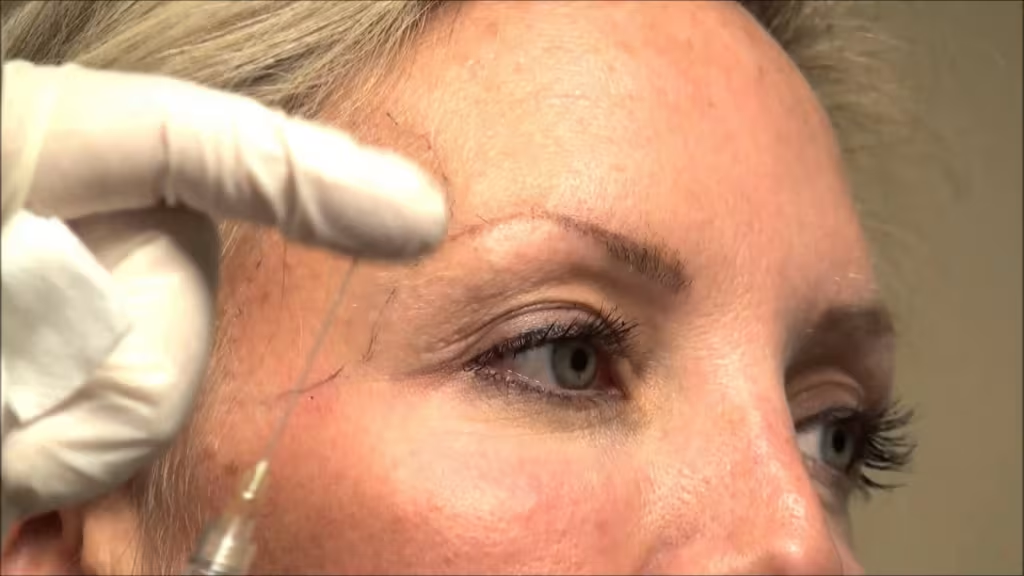Temple fillers are an often overlooked but highly effective cosmetic treatment that can significantly rejuvenate your facial appearance.
While not as commonly discussed as other facial fillers, temple fillers address a specific concern that can dramatically impact how youthful you look.
This comprehensive guide explores everything you need to know about temple fillers in Singapore, from understanding what they are to choosing the right practitioner for your treatment.
Understanding Temple Fillers
Temple fillers are injectable treatments specifically designed to restore lost volume in the temple area—the region on either side of your forehead between your eyebrows and hairline.
As we age, we naturally lose bone, fat, and collagen throughout our face, including the temple area.
This volume loss can create hollow or sunken temples, disrupting the smooth facial contours that characterize a youthful appearance.
When your temples become hollow, they can create an aged, gaunt, or tired appearance.
This hollowing not only affects how the upper face looks but can also impact the overall facial harmony and balance.
Temple fillers address this concern by replenishing lost volume, restoring the natural contours, and creating a more refreshed and youthful appearance.
Read more: Dermal Fillers in Singapore: The Comprehensive Guide
Why Consider Temple Fillers?
Although temple fillers might not be as well-known as other facial treatments, they offer several significant benefits:
Restoring the Ogee Curve
Temple fillers help maintain or restore what aesthetic experts call the “Ogee curve“—the smooth S-shaped contour that runs from your cheekbone to your jawline.
When temple hollowing occurs, this desirable curve is disrupted, making you appear older than you actually are.
Creating a Heart-Shaped Face
Many people consider a heart-shaped face (or “Gua-zi lian” in Chinese culture) to be aesthetically pleasing.
Temple fillers can help achieve this desirable facial shape by adding volume to the upper face, making your face appear more proportionate, feminine, and youthful.
You might be interested: HydraFacial Singapore: Benefits, Costs, Risks
Lifting the Eyebrows and Eyes
An additional benefit of temple fillers is their ability to provide subtle support to the eyebrow area.
As the temples become fuller, they help lift the eyebrows slightly, creating a more refreshed and alert appearance.
This can be particularly beneficial for people who have started noticing drooping in their upper eyelids.
You might like: How to Get Rid of Smile Lines
Softening a Prominent Orbital Rim
Some individuals have a more prominent orbital rim (the protruding bone above the sides of the eyes), which can make them appear older or give a more intense look.
Temple fillers, sometimes combined with forehead fillers, can soften this protrusion for a gentler, more youthful appearance.
This might help: List of Aesthetic Treatments and Costs in Singapore
Who Can Benefit from Temple Fillers?

Temple fillers can benefit a variety of individuals:
- Those with Age-Related Volume Loss: If you’ve noticed your temples becoming increasingly hollow with age, temple fillers can effectively restore this lost volume.
- Individuals with Naturally Thin Temples: Some people naturally have thin temples regardless of age. Temple fillers can add volume to create more balanced facial proportions.
- Those Seeking Non-Surgical Facial Rejuvenation: If you’re looking for a non-invasive way to refresh your appearance, temple fillers offer noticeable improvements with minimal downtime.
- Patients Seeking a Complete Facial Enhancement: Temple fillers work well as part of a comprehensive facial rejuvenation plan, often combined with other treatments for overall facial harmony.
You might be interested: What Treatment is Best for Anti-Aging?
Types of Temple Fillers Available in Singapore
In Singapore, practitioners typically use two main types of fillers for the temple area:
Hyaluronic Acid (HA) Fillers
HA fillers like Juvederm are the most commonly used option. These fillers are popular because:
- They provide immediate, visible results
- They can be dissolved if necessary using hyaluronidase (a dissolving agent)
- They typically last 12-18 months
- They have a proven safety record
Collagen Stimulator Fillers
Products like Ellanse and Sculptra work differently from HA fillers. These stimulate your body’s natural collagen production over time and typically offer:
- Longer-lasting results (2-3 years)
- A more gradual, natural-looking enhancement
- Progressive improvement over several months
Related article: Complete Guide to Ellansé Dermal Fillers
The Temple Filler Procedure

Initial Consultation
Before undergoing temple filler treatment, you’ll have a consultation with your doctor. During this appointment, the doctor will:
- Assess your facial anatomy
- Discuss your aesthetic goals
- Explain the procedure and potential outcomes
- Address any questions or concerns you might have
- Recommend the most suitable type and amount of filler
You might like: Guide to Finding a Good Aesthetic Doctor in Singapore
The Treatment Process

The actual temple filler procedure typically follows these steps:
- Preparation:
- The treatment area is thoroughly cleansed
- A topical numbing cream is applied (usually requiring about 20 minutes to take effect)
- The injection sites are marked for precision
- Injection:
- The doctor will inject the filler using either a fine needle or a micro-cannula
- The injection technique will be selected based on your specific anatomy and the type of filler used
- The procedure usually takes 10-15 minutes after numbing
- Massage and Assessment:
- After injection, the doctor will gently massage the area to ensure even distribution
- The results are assessed to ensure symmetry and desired outcome
Amount of Filler Required
The amount of filler needed varies based on individual factors, including:
- The extent of volume loss
- Your facial anatomy
- Your aesthetic goals
On average, most patients require about 1-2 ml (1-2 syringes) of filler per temple. However, cases with significant volume loss may require more.
Your doctor will determine the appropriate amount during your consultation.
Results and Longevity
Immediate and Final Results
You’ll notice immediate improvement in your temple area right after the procedure. However, the final results may take 1-2 weeks to develop as any swelling subsides and the filler settles.
Duration of Results
The longevity of temple fillers depends on the type used:
- Hyaluronic acid fillers typically last 12-18 months
- Collagen stimulator fillers like Ellanse or Sculptra can last 2-3 years
Individual factors like metabolism, lifestyle, and the specific product used can influence how long your results last.
Recovery and Aftercare
Downtime and Recovery
Temple filler treatments have minimal downtime. Most patients can return to their normal activities immediately after the procedure. However, you might experience:
- Mild swelling for 1-3 days
- Potential bruising that typically resolves within a week
- Occasional mild headache for 1-2 days after treatment
Aftercare Instructions
To ensure optimal results and minimize complications, follow these aftercare guidelines:
- Avoid strenuous exercise for 24 hours
- Avoid alcohol consumption for at least 24 hours
- Don’t touch or massage the treated area for the first 24 hours
- Avoid facial massages for at least 2 weeks
- Sleep on your back for the first few nights if possible
- Apply cold compresses if swelling occurs
Potential Side Effects and Risks
Common Side Effects
Most side effects from temple fillers are mild and temporary:
- Redness at the injection site
- Swelling and bruising
- Tenderness or mild discomfort
- Potential headache
These typically resolve within a few days without intervention.
Rare but Serious Complications
- Vascular Occlusion: This occurs when filler is accidentally injected into or compresses a blood vessel, blocking blood flow. In extreme cases, this could lead to skin necrosis (tissue death) or even blindness if it affects vessels connected to the eye.
- Infection: As with any injectable procedure, there’s a small risk of infection.
- Asymmetry or Lumps: Improper technique can result in uneven results or visible lumps.
Minimizing Risks
To reduce these risks, experienced doctors employ specialized techniques:
- Using the appropriate equipment and filler type for the temple area
- Performing aspiration (drawing back on the syringe) to ensure the needle isn’t in a blood vessel
- Injecting slowly and precisely at the correct depth
- Having thorough knowledge of facial anatomy to avoid major blood vessels
- Using blunt cannulas instead of sharp needles in some cases to reduce vascular risks
Choosing the Right Practitioner in Singapore
The temple area contains important blood vessels and nerves, making it a more technically challenging area to treat.
Therefore, choosing a qualified and experienced practitioner is crucial for both safety and results.
What to Look For:
- Medical Credentials: Ensure your practitioner is a MOH-certified doctor with specific training in facial aesthetics.
- Experience with Temple Fillers: Ask about their experience specifically with temple filler treatments.
- Before and After Photos: Request to see examples of their previous temple filler work.
- Patient Reviews: Look for testimonials from previous patients who have undergone similar treatments.
- Thorough Consultation: A good practitioner will conduct a comprehensive assessment and explain all aspects of the treatment before proceeding.
- Emergency Protocols: They should have protocols in place to manage any potential complications.
Combining Temple Fillers with Other Treatments
For comprehensive facial rejuvenation, temple fillers are often combined with other treatments:
Complementary Treatments
- Under-eye Fillers: Addressing hollowness under the eyes along with temple fillers can create a more harmonious upper face.
- Cheek Fillers: Enhancing cheek volume can work synergistically with temple fillers to restore youthful facial contours.
- Botox: Combining temple fillers with Botox treatments for the forehead or eye area can provide more comprehensive rejuvenation.
- Skin Treatments: Procedures like lasers, chemical peels, or microneedling can improve skin quality while fillers address volume concerns.
Cost of Temple Fillers in Singapore
The cost of temple fillers in Singapore varies based on several factors:
- The type of filler used (HA fillers versus collagen stimulators)
- The amount of filler required
- The experience and reputation of the practitioner
- The clinic’s location and facilities
While prices can range significantly, expect to invest between $600-$1,200 per syringe of filler. Most patients require 1-2 syringes per temple.
Frequently Asked Questions About Temple Fillers
Are temple fillers dangerous?
Temple fillers are generally safe when performed by qualified, experienced practitioners.
However, the temple area contains important blood vessels and nerves, making proper technique essential.
The most serious risks include vascular occlusion (blockage of blood vessels) which could potentially lead to tissue damage.
This risk is significantly minimized when the procedure is performed by an experienced doctor with detailed knowledge of facial anatomy.
Is the temple filler procedure painful?
Most patients report minimal discomfort during temple filler injections. Before the procedure, a topical numbing cream is applied to the treatment area, and many fillers contain lidocaine (a local anesthetic) to further reduce discomfort.
Some patients may feel pressure or a slight pinching sensation during the injection, but severe pain is uncommon.
Some individuals may experience a mild headache for 1-2 days after the procedure, which typically resolves naturally.
How long is the recovery time after temple fillers?
Recovery from temple fillers is generally quick. Most patients can return to normal activities immediately after treatment.
Common side effects like swelling and bruising typically resolve within 3-7 days.
To minimize downtime, avoid alcohol, strenuous exercise, and facial massages for at least 24 hours after the procedure.
Do temple fillers completely dissolve over time?
Most hyaluronic acid fillers will naturally break down and be absorbed by the body over time, eventually dissolving completely.
The body metabolizes these fillers into water and carbon dioxide. However, in rare cases, some filler material may last longer than expected.
If this occurs or if you’re unhappy with the results, hyaluronic acid fillers can be dissolved using an enzyme called hyaluronidase.
Collagen stimulator fillers like Ellanse or Sculptra work differently—they stimulate your body’s collagen production and their carrier gel eventually dissolves, but the collagen they stimulate remains.
Can temple fillers lift my eyebrows?
Yes, one of the benefits of temple fillers is that they can provide subtle support to the lateral (outer) portion of the eyebrows, creating a slight lifting effect.
This can help patients look more refreshed and alert. However, for more significant eyebrow lifting, complementary treatments like Botox might be recommended in addition to temple fillers.
When will I see results from temple fillers?
Results from temple fillers are visible immediately after the procedure. However, there may be some initial swelling that can make the area look more filled than it will be once settled.
The final results typically become apparent after 1-2 weeks when any swelling has completely subsided and the filler has fully integrated with your tissues.
Can men get temple fillers too?
Absolutely. Temple hollowing affects both men and women, and men can benefit equally from temple fillers.
The treatment approach may differ slightly for men to maintain masculine facial characteristics, but the procedure itself is suitable for all genders.
How do I know if I need temple fillers?
You might benefit from temple fillers if you notice hollow or sunken areas at your temples, if the sides of your forehead appear concave rather than slightly convex, or if you feel your face is losing its youthful contours.
A consultation with an experienced aesthetic doctor can help determine if temple fillers would benefit your particular facial structure and concerns.
What happens if I don’t like the results?
If you’re unhappy with the results of hyaluronic acid fillers, they can be dissolved using hyaluronidase, an enzyme that breaks down the filler material.
This provides a significant safety advantage compared to other types of fillers.
For collagen stimulators, modification options are more limited, which is why thorough consultation and choosing an experienced doctor are particularly important.
Can temple fillers help with temporal headaches?
Some patients who suffer from temporal headaches have reported improvement after temple filler treatment, possibly due to the cushioning effect of the filler.
However, temple fillers are not specifically designed or approved as a treatment for headaches, and results vary significantly between individuals.
If you suffer from chronic headaches, it’s important to consult with a neurologist or headache specialist.
Is there anyone who shouldn’t get temple fillers?
Temple fillers may not be suitable for individuals with:
- Active skin infections near the treatment area
- History of severe allergic reactions to filler ingredients
- Bleeding disorders or those taking blood thinners (though treatment may still be possible with modifications)
- Unrealistic expectations about the outcomes
- Certain autoimmune conditions (depending on the specific condition and its severity)
A thorough medical consultation will help determine if you’re a suitable candidate for temple fillers.
Conclusion
Temple fillers represent a sophisticated yet subtle approach to facial rejuvenation that can dramatically improve your appearance by restoring lost volume and enhancing facial contours.
While not as commonly discussed as other facial fillers, they offer significant benefits, particularly for those experiencing age-related volume loss in the upper face.
When performed by qualified practitioners in Singapore, temple fillers provide safe, effective results with minimal downtime.
To ensure optimal outcomes, research thoroughly, choose an experienced doctor, and maintain realistic expectations about what temple fillers can achieve.
Whether used alone or as part of a comprehensive facial rejuvenation plan, temple fillers can help you maintain a youthful, refreshed appearance while preserving your natural facial expressions and characteristics.

